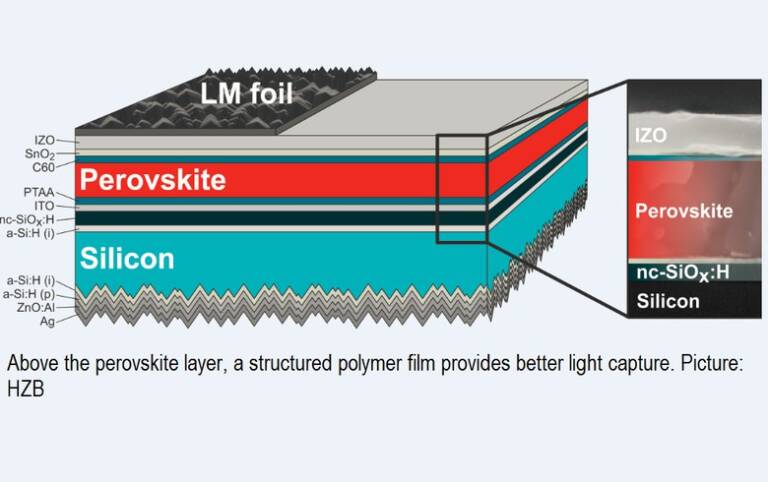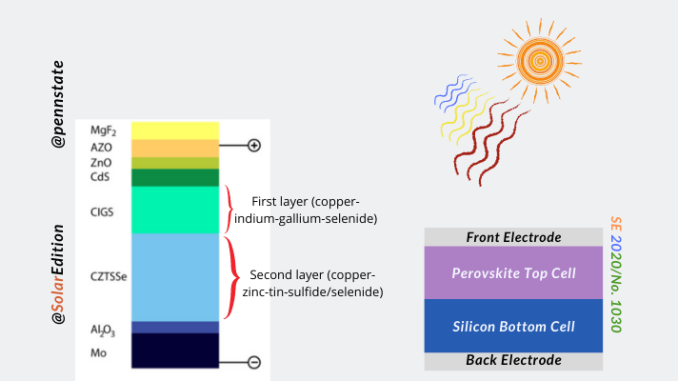Solar cells with an efficiency of 32.5%. The exceptional performance of binary technology

Researchers from Kaunas University of Technology report in a new paper on improvements in silicon-perovskite tandem cells. In the ongoing search for more efficient solar cells, the most recent new record published by the University of Kaunas for tandem perovskite solar cells is now at 32.5%.
Dr Artiom Magomedov, a researcher at Kaunas University of Technology, Lithuania, noted: “There is a kind of race going on between research groups around the world. In the last year the efficiency record of solar cells has been broken three or four times, it's just the publication of scientific articles that takes time."
According to Dr. Magomedov, co-author of a recent paper published in the scientific journal Science, the most recent published record for tandem perovskite solar cells is 32.5% . The article reports on the improvements made to silicon-perovskite tandem cells that made this possible.
Dr Magomedov, a researcher at Kaunas University of Technology (KTU), Lithuania, explained: “Tandem solar cells have more than ten layers, so it is technologically very challenging to ensure their smooth operation. The development of such solar cells involves a large number of researchers. For example, our research group is responsible for one of the layers, which is made up of hole-carrying materials.”
In 2018, a group of chemists at KTU synthesized a material that forms a one-molecule-thick layer, also known as a monolayer, that uniformly covers a variety of surfaces. Several highly efficient solar cells have already been developed using this material. According to Dr. Magomedov, one of the authors of the invention, the KTU innovation has become commonplace among scientists developing the latest solar technologies.
Mass production of next-generation solar cells will have to wait
The recent scientific article is the second publication in Science co-authored by Dr. Magomedov and serves as a follow-up to the previous one, proposing a solution to the ongoing challenge.
“ Although our materials help achieve maximum efficiency, it is difficult to form another layer on top. After our previous article in Science, we received a lot of attention and comments on how our materials work in different contexts. In this paper we show a way to address the problems ,” said Dr. Magomedov.
More details on the improvement proposed by the KTU research group, which, together with solutions developed by other scientists around the world, led to the construction of a very high efficiency tandem solar cell, can be found in the scientific article. The ultra-high efficiency tandem solar cell was built by a research team led by Professor Steve Albrecht from the Helmholtz-Zentrum in Berlin, Germany.
Silicon solar cells have a potential peak efficiency of only 29%; The world needs more and more alternative energy sources due to the climate change crisis. Tandem solar cells consist of two types of photoactive layers: a perovskite solar element is placed on top of the silicon. The silicon layer collects infrared light, while the perovskite collects blue light from the visible spectrum, increasing the efficiency of the solar cell. However, according to Dr Magomedov, it will still take some time before the new generation of solar cells replaces those in use today.
“In theory, the electricity produced by tandem solar cells would be cheaper because the additional materials used are cheaper. However, in practice, the final commercial product does not exist, the technological processes are not ready for mass production. Furthermore, the cell itself, which has so far only been developed in the laboratory, also raises unanswered questions. For example, not all materials are suitable for mass production, which means that alternatives need to be found,” explained Magomedov.
One of the biggest challenges faced so far in producing these cells, he says, is their stability. Solar cells are expected to last 25 years, during which they will lose 10% of their efficiency. Too bad it's difficult to carry out tests that simulate such a long period of time.
Lithuanian chemists – world experts in new materials for solar cells
The synthesis and analysis of chemical materials for solar technologies has been the topic of Dr Magomedov since the beginning of his university studies, when he joined a research group led by Professor Vytautas Getautis from KTU. When the need for new materials for solar cells arose, talented chemists used their skills and established themselves in the niche that opened up, gaining international recognition.
“We are probably the most specialized research group in the world,” joked Dr. Magomedov.
He said that good results are motivating, offer interesting prospects for collaboration and open up new research opportunities. It's great to contribute to a global scientific breakthrough. Furthermore, Dr. Magomedov said, the development of solar technologies is a highly topical issue in the context of today's world and the inventions can be widely applied.
“In general, we are working with new electronics with a very wide range of applications. And, of course, in the very topic of solar technology, the problem of solar energy storage and batteries inevitably emerges,” noted Dr. Magomedov.
Currently, a research group of KTU chemists led by Professor Getautis is involved in a project to develop a pilot production line for silicon-perovskite tandem solar cells and is looking for ways to apply the developed materials to other technologies, such as emitting diodes of light. At the same time, fundamental questions are also addressed, for example why semiconductors developed in the laboratory work in a certain way.
The promise of cells with high yield and acceptable cost is one of the most important innovations expected for the renewable energy sector, which could truly change attitudes towards these energy sources.

Thanks to our Telegram channel you can stay updated on the publication of new Economic Scenarios articles.
The article Solar cells with an efficiency of 32.5%. The outstanding performance of binary technology comes from Economic Scenarios .
This is a machine translation of a post published on Scenari Economici at the URL https://scenarieconomici.it/celle-solari-con-un-rendimento-del-325-le-prestazioni-eccezionali-della-tecnologia-binaria/ on Wed, 20 Sep 2023 18:44:26 +0000.

